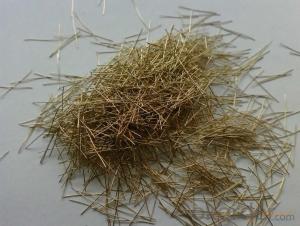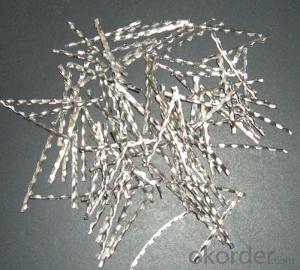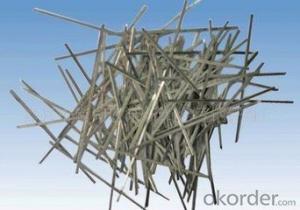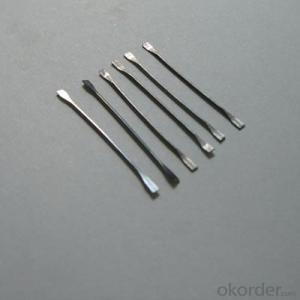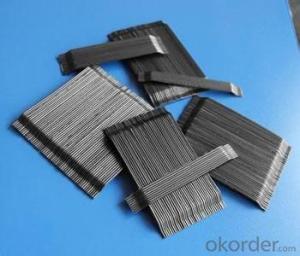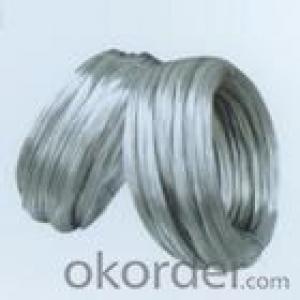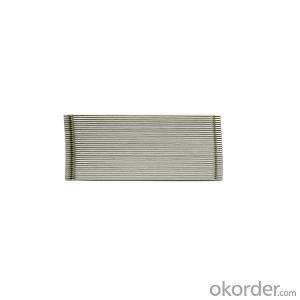Steel Fiber Copper Coated Company From China CNBM International
- Loading Port:
- Tianjin
- Payment Terms:
- TT OR LC
- Min Order Qty:
- 1000 kg
- Supply Capability:
- 30000 kg/month
OKorder Service Pledge
OKorder Financial Service
You Might Also Like
Quick Details
| Place of Origin: | Hebei, China (Mainland) | Brand Name: | cnbm | Model Number: | CW04 |
| Material: | Steel | Material:: | Steel,low carbon steel wire | Standard:: | ASTM ,ISO9001,CE |
| Shape:: | hooked ends and straight middle | Grade:: | Q195 | Application:: | shortcrete on tunnel, underground project, dam plate |
| Tensile strength:: | 2850Mpa | Demension:: | per your requirement | Place of Origin:: | HeBei China (Mainland) |
| Brand Name:: | ZhiTai steel fiber | Delivery Detail:: | in 7 days upon receive prepayment |
Specifications
Steel fiber for Concrete Reinforcement
1.High tensile strength 2.Length 6-10mm 3.Diameter 0.15-0.3mm
Copper coated steel fiber
1. diameter: 0.15-0.3mm
2. lengthe: 6-10mm
3. high tensile strength : 2850Mpa
4. It is widely used for concrete reinforcement.
Picture
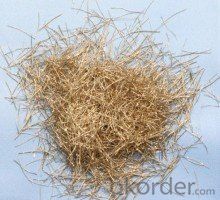
Steel fiber
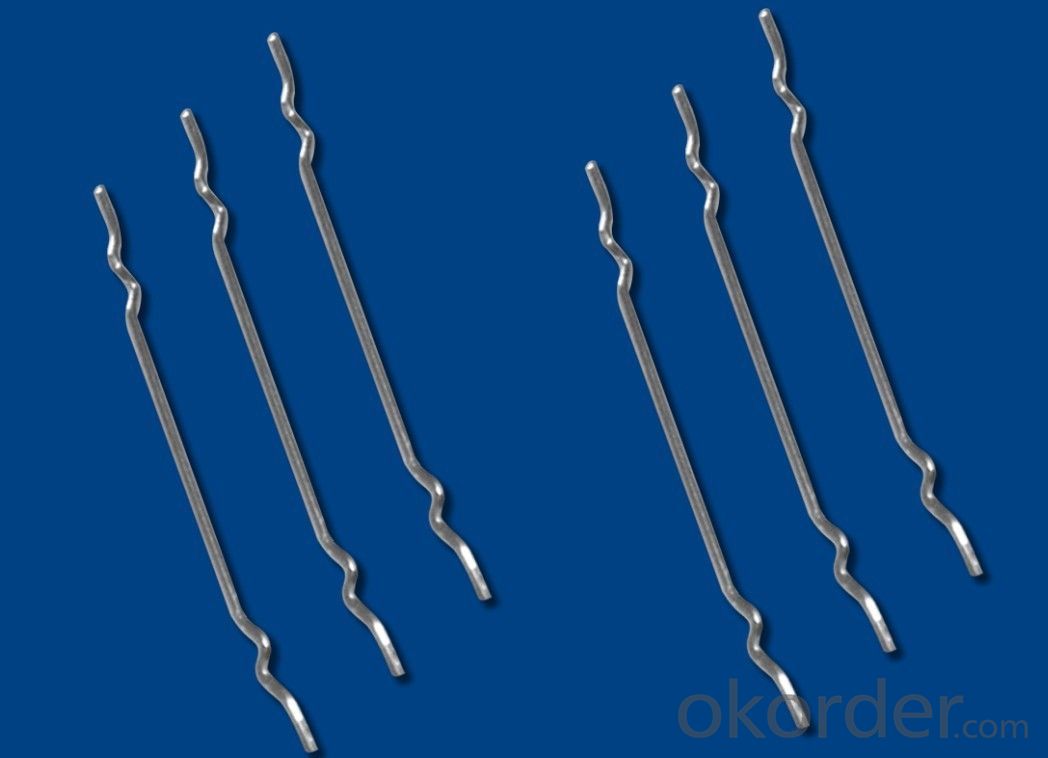
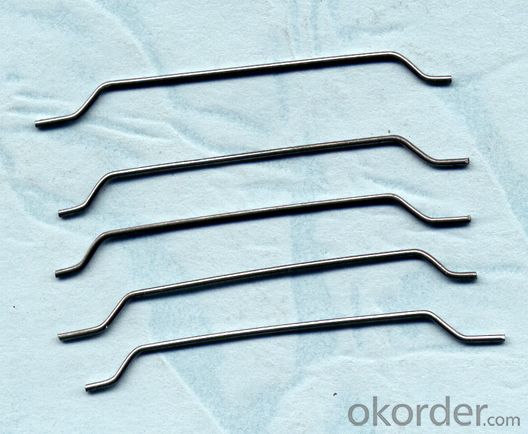
FAQ
certificated: ISO 9001
Technical advantages of Daye steel fiber:
A. Improve mechanical performance of concrete
B. Provide uniform distribution throughout concrete with excellent mixing
C. No balling or caking by adopt correct mixing method
D. Reduce concrete volume
E.Save construction time and cost
F.Reduce excavation volume
G.Available for jointless floor.
- Q:What is the lifespan of melt extract stainless steel fiber in concrete structures?
- The lifespan of melt extract stainless steel fiber in concrete structures can vary depending on several factors. Firstly, the quality of the stainless steel fiber used plays a crucial role in determining its lifespan. High-quality melt extract stainless steel fibers are typically more resistant to corrosion and can withstand harsh environmental conditions, resulting in a longer lifespan. Secondly, the exposure conditions of the concrete structure also affect the durability of the stainless steel fiber. Concrete structures exposed to aggressive environments such as marine or industrial areas with high chloride or chemical content may experience accelerated corrosion, which can reduce the lifespan of the stainless steel fiber. Additionally, the design and construction practices of the concrete structure can impact the performance and longevity of the stainless steel fiber. Proper installation techniques, including correct fiber distribution and embedding, help ensure the fiber's optimal performance and durability over time. In general, if the stainless steel fiber is of high quality and the concrete structure is properly designed and constructed, melt extract stainless steel fiber can have a lifespan ranging from 30 to 50 years or more. However, it is essential to regularly inspect and maintain the concrete structure to identify any potential issues or signs of deterioration that may impact the lifespan of the stainless steel fiber.
- Q:Can melt extract stainless steel fiber be used in the construction of parking structures?
- Indeed, the utilization of melt extract stainless steel fiber is feasible for the construction of parking structures. It is a prevalent practice to employ stainless steel fibers as reinforcement in concrete to augment its robustness and endurance. This type of fiber possesses the ability to enhance the resistance of concrete against cracks and impacts, rendering it more suitable for areas with high vehicular movement, like parking structures. Furthermore, the outstanding resistance to corrosion exhibited by stainless steel fibers enables them to withstand adverse environmental conditions, thus guaranteeing the durability of the parking structure. In summary, incorporating melt extract stainless steel fiber into the construction of parking structures is a viable alternative that can bolster their structural integrity and prolong their lifespan.
- Q:How is the dosage of melt extract stainless steel fiber determined for concrete reinforcement?
- The amount of melt extract stainless steel fiber used for reinforcing concrete depends on several factors, including project requirements, the type of concrete, and desired concrete properties. To determine the dosage, extensive testing and analysis are typically conducted to ensure that the reinforced concrete meets the desired performance criteria. The dosage is usually expressed as a percentage of the weight or volume of the concrete relative to the stainless steel fiber. The first step is to evaluate the project requirements, such as the design strength, durability, and crack resistance of the concrete. This information helps identify the necessary properties that the stainless steel fiber should provide. Laboratory testing is then performed to assess the compatibility between the stainless steel fiber and the concrete mix. This includes evaluating the bonding characteristics, dispersibility, and the impact on the fresh and hardened properties of the concrete. The dosage is adjusted based on the test results to optimize the performance of the reinforced concrete. The type of concrete being used also influences the dosage. Different concrete mixes have different characteristics, such as aggregate sizes, water-cement ratios, and admixtures. These factors affect the amount of stainless steel fiber required to achieve the desired properties. Additionally, the desired properties of the reinforced concrete, such as flexural strength, impact resistance, and crack control, also impact the dosage. Applications that require superior performance in these properties generally require higher dosages of stainless steel fiber. It is important to carefully determine the dosage to avoid negative effects on the workability of the concrete mix. Excessive dosages can make it difficult to place and finish the concrete and may cause segregation or clumping of the fiber. In conclusion, determining the dosage of melt extract stainless steel fiber for concrete reinforcement involves analyzing project requirements, concrete characteristics, and desired properties. Through extensive testing and evaluation, the dosage is optimized to effectively enhance the performance of the concrete.
- Q:Can melt extract stainless steel fiber be used in seismic-resistant concrete applications?
- Yes, melt extract stainless steel fiber can be used in seismic-resistant concrete applications. Stainless steel fibers are commonly used as reinforcement in concrete to enhance its strength, durability, and ductility. In seismic-resistant concrete applications, stainless steel fibers help to improve the concrete's resistance to cracking and enhance its ability to withstand the dynamic forces generated during an earthquake. The melt extract stainless steel fibers are particularly suitable for such applications due to their high tensile strength, corrosion resistance, and ability to disperse uniformly within the concrete matrix. They effectively reinforce the concrete and provide enhanced crack control, reducing the risk of structural failure during seismic events. Therefore, using melt extract stainless steel fiber in seismic-resistant concrete can significantly improve the overall performance and safety of the structure.
- Q:How does melt extract stainless steel fiber affect the shear strength of concrete?
- Melt extract stainless steel fiber has a significant impact on the shear strength of concrete. When added to the concrete mixture, these fibers enhance its overall structural integrity and resistance to shear forces. The fibers act as reinforcement by bridging cracks and distributing stress throughout the concrete matrix. The addition of melt extract stainless steel fibers increases the interlocking effect between the fibers and the surrounding concrete matrix, resulting in improved shear strength. These fibers effectively resist the forces that cause concrete to crack and fail under shear loads. They prevent the propagation of cracks by transferring shear stresses across the crack faces, thus increasing the shear resistance of the concrete. Furthermore, the high tensile strength and ductility of stainless steel fibers make them highly effective in enhancing the shear capacity of concrete. The fibers absorb energy during loading and dissipate it through deformation, which helps to delay and control the development of cracks. This ultimately improves the shear resistance and overall durability of the concrete structure. It is important to note that the effectiveness of melt extract stainless steel fibers in enhancing shear strength depends on various factors such as fiber content, aspect ratio, and distribution within the concrete mixture. The optimal dosage and distribution of fibers should be carefully considered to achieve the desired improvement in shear strength. Additionally, proper concrete mix design and fiber dispersion techniques are crucial to ensure the successful integration and performance of the stainless steel fibers. In summary, the addition of melt extract stainless steel fibers significantly improves the shear strength of concrete by enhancing its crack resistance, transferring shear stresses, and absorbing energy. These fibers play a crucial role in reinforcing the concrete matrix and increasing its overall structural integrity, making it more resistant to shear forces and improving the durability of the concrete structure.
- Q:Can melt extract stainless steel fiber be used in architectural precast elements?
- Yes, melt extract stainless steel fibers can be used in architectural precast elements. These fibers are commonly added to concrete mixes to improve the strength, durability, and performance of the precast elements. The stainless steel fibers are typically added in small percentages by volume to the concrete mix during the batching process. They help to enhance the flexural strength, impact resistance, and crack resistance of the precast elements. Additionally, the stainless steel fibers also provide corrosion resistance, which is particularly beneficial in architectural precast elements that may be exposed to harsh environmental conditions or corrosive chemicals. Overall, the use of melt extract stainless steel fibers in architectural precast elements can result in higher quality and longer-lasting structures.
- Q:How does melt extract stainless steel fiber impact the early-age cracking of concrete?
- Melt extract stainless steel fiber has a significant impact on the early-age cracking of concrete. These fibers are added to the concrete mixture to enhance its mechanical properties and reduce the occurrence of cracks during the early stages of curing. The main reason behind early-age cracking in concrete is the rapid evaporation of moisture from the surface. This causes shrinkage and tensile stresses within the concrete, leading to cracks. However, when melt extract stainless steel fibers are incorporated into the concrete mix, they act as reinforcement and provide additional strength and stability. The stainless steel fibers distribute the stress load more evenly throughout the concrete, preventing the concentration of tensile forces at any particular point. This reduces the likelihood of cracking and enhances the overall durability of the concrete structure. Furthermore, the presence of stainless steel fibers also improves the microstructure of the concrete. They act as nucleation sites for the formation of hydration products, resulting in a denser and more compact matrix. This densification reduces the permeability of the concrete, making it more resistant to moisture loss and minimizing the potential for early-age cracking. Moreover, the stainless steel fibers also enhance the post-cracking behavior of the concrete. In the event that cracks do occur, the fibers provide bridging effects, preventing the cracks from propagating further and potentially compromising the structural integrity. This ensures that even if cracks occur during the early stages, they will not develop into larger, more significant cracks over time. In summary, the addition of melt extract stainless steel fibers to concrete significantly reduces the early-age cracking. They enhance the mechanical properties, distribute stress load, improve microstructure, and provide bridging effects. These fibers effectively mitigate the shrinkage and tensile stresses, resulting in a more durable and crack-resistant concrete structure.
- Q:How does melt extract stainless steel fiber improve the bond strength of concrete?
- Melt extract stainless steel fiber is known for its ability to significantly improve the bond strength of concrete. The unique properties of this fiber contribute to its effectiveness in enhancing the bond between the concrete matrix and the reinforcement. Firstly, the melt extract stainless steel fiber has a high aspect ratio, meaning it has a long and slender shape. This characteristic allows the fiber to penetrate deeply into the concrete matrix, resulting in a larger surface area for bond formation. As a result, the bond strength is improved as the fiber forms a strong interlocking network within the concrete. Secondly, the stainless steel fiber is manufactured using a melt extraction process, which ensures a clean and uniform composition. This uniformity and absence of impurities contribute to a better bond with the concrete matrix. The smooth surface of the fiber also prevents any weak points or irregularities that could weaken the bond strength. Additionally, the stainless steel material itself possesses high tensile strength and excellent corrosion resistance. These properties allow the fiber to withstand the forces and environmental conditions that may degrade the bond strength of traditional reinforcement, such as corrosion or chemical attack. Therefore, the use of melt extract stainless steel fiber in concrete significantly improves the durability and long-term performance of the structure. In summary, melt extract stainless steel fiber improves the bond strength of concrete by providing a high aspect ratio for better penetration, uniform composition for a consistent bond, and strong material properties to withstand external forces. This fiber reinforcement enhances the overall strength and durability of the concrete structure, making it an excellent choice for various construction applications.
- Q:How does melt extract stainless steel fiber affect the fatigue resistance of concrete?
- Melt extract stainless steel fiber can significantly improve the fatigue resistance of concrete. When added to the concrete mix, these fibers enhance the overall durability and strength of the material, making it more resistant to cracking and structural failures caused by repetitive loading or cyclic stress. The unique properties of stainless steel fibers, such as high tensile strength and excellent corrosion resistance, contribute to their ability to enhance the fatigue resistance of concrete. These fibers act as reinforcement within the concrete matrix, effectively bridging cracks and preventing their propagation under cyclic loading. By dispersing evenly throughout the concrete mixture, melt extract stainless steel fibers create a three-dimensional network that enhances the overall structural integrity. This network helps to distribute the applied stress more evenly, reducing stress concentrations and minimizing the risk of fatigue failure. Additionally, the high corrosion resistance of stainless steel fibers ensures that they maintain their structural integrity over time. This is particularly important in concrete structures exposed to harsh environmental conditions or corrosive agents, as the fibers will not degrade or weaken due to corrosion, thereby preserving their beneficial effects on fatigue resistance. In summary, incorporating melt extract stainless steel fibers into concrete significantly improves its fatigue resistance by reinforcing the material and enhancing its ability to withstand cyclic loading or repetitive stress. The fibers act as crack arresters, distribute stress more evenly, and provide long-term durability due to their corrosion resistance.
- Q:What is the recommended dosage of melt extract stainless steel fiber in concrete mixtures?
- The recommended dosage of melt extract stainless steel fiber in concrete mixtures can vary depending on the specific application and desired outcome. Generally, the dosage ranges from 20 to 40 kilograms per cubic meter (kg/m³) of concrete. However, it is important to consult with the manufacturer or a structural engineer to determine the optimal dosage for a particular project. Factors that can influence the dosage include the intended use of the concrete (such as industrial flooring, precast elements, or shotcrete), the required level of reinforcement, and the specific properties desired from the stainless steel fiber, such as improved crack resistance, impact resistance, or durability. It is also worth noting that the length and diameter of the stainless steel fibers can impact the dosage. Longer and thicker fibers typically require a lower dosage to achieve the desired reinforcement effect. Ultimately, it is crucial to consult with professionals and consider the specific requirements and objectives of the project to determine the most appropriate dosage of melt extract stainless steel fiber in concrete mixtures.
1. Manufacturer Overview |
|
|---|---|
| Location | |
| Year Established | |
| Annual Output Value | |
| Main Markets | |
| Company Certifications | |
2. Manufacturer Certificates |
|
|---|---|
| a) Certification Name | |
| Range | |
| Reference | |
| Validity Period | |
3. Manufacturer Capability |
|
|---|---|
| a)Trade Capacity | |
| Nearest Port | |
| Export Percentage | |
| No.of Employees in Trade Department | |
| Language Spoken: | |
| b)Factory Information | |
| Factory Size: | |
| No. of Production Lines | |
| Contract Manufacturing | |
| Product Price Range | |
Send your message to us
Steel Fiber Copper Coated Company From China CNBM International
- Loading Port:
- Tianjin
- Payment Terms:
- TT OR LC
- Min Order Qty:
- 1000 kg
- Supply Capability:
- 30000 kg/month
OKorder Service Pledge
OKorder Financial Service
Similar products
New products
Hot products
Hot Searches
Related keywords
